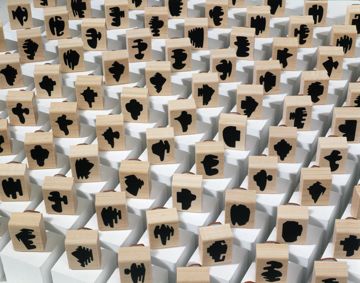
Allan McCollum, The Shapes Project: Shapes From Maine (Shapes Rubber Stamps) 2005/2008 Courtesy Friedrich Petzel Gallery
Recently I have participated in a few discussions that relate to teaching students about slowing down and examining their process in order to create quality works of art- works that are more than exercises or quick fixes to visual problems. Even this past Monday evening two of our current Art21 Educators, Cynthia Schubert and Lauren Taylor, brought up the challenge of not rushing students through units of study in order to “get to the project”. But how do we get students to enjoy process as much as creating the final product? Should we even try?
Students need to be conscious of what and how they plan in order to make good decisions. They need to be taught, through a different kind of classroom culture, that the journey is indeed important, along with the destination. Leaving a trail of breadcrumbs through sketching, keeping visual journals, taking risks with media, and having all kinds of discussion are some of the ways we can train students to decelerate and take note of the steps involved in making dynamic works of art.
But it doesn’t have to end there.
Taking a field trip to a museum, gallery, artist’s studio or public space to examine how and why certain works of art are as much about process as they are the final product is another way. Exploring a collaborative project in depth is still another. An example would certainly involve two exhibits since 2006 at Friedrich Petzel Gallery featuring The Shapes Project and Shapes from Maine by Allan McCollum. The gallery press release from 2006 states:
Working over the past few years, McCollum has designed a new system to produce unique two-dimensional “shapes.” This system allows him to make enough unique shapes for every person on the planet to have one of their own. It also allows him to keep track of the shapes, so as to insure that no two will ever be alike.
For the time being, around 214,000,000 of the shapes have been set aside for creative experimentation. These can be used for many different purposes — not only for fine art and design projects, but also for various social practices: as gifts, awards, identity markers, emblems, insignias, logos, toys, souvenirs, educational tools, and so forth. The shapes can be printed graphically as silhouettes or outlines, in any size, color or texture, using all varieties of graphics software to build, carve, or cut the shapes from wood, plastic, metal, stone, and other materials.
The basic system for making the shapes is now complete, but the project of actually constructing all of them is much too large for McCollum to finish by himself, or in his own lifetime. For this reason he is organizing it in such a way that others may continue completing them in his absence. He is also making shapes available to others, with the hope that people will come up with many interesting ways to use them.
In McCollum’s work, the process involved in creating these shapes and the relationships that develop through working with others on a project like this become part of what the work is about- just as much as what the final product looks like. And since this is a project that McCollum started, fully realizing that it cannot be “finished” in his lifetime, the work acts as a story that unfolds vs. being “born” as a singular object into the world.
Allowing students to discuss and investigate not only why this project is a work of art, but also why an artist like Allan McCollum would even take on such a project can act as steps for getting them to better understand artistic process. Perhaps challenging students to take on collaborative projects in the spirit of McCollum’s work can also move them to consider how works take shape over time… and even enjoy each step along the way a little more.



